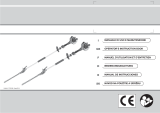
29
GB
Most materials used in the manufacture of the
machine are recyclable; all metals (steel,
aluminium, brass) can be delivered to a normal
recycling station. For information contact your
local waste recycling service. Waste disposal must
be carried out with respect for the environment,
avoiding soil, air and water pollution.
In all cases, applicable local legislation must
be complied with.
When the machine is scrapped also the CE mark
label must be destroyed together with this
manual.
12. VACUUM / SHREDDER VERSION
ASSEMBLY
Optional vacuum / shredder kit:
1. Vacuum tube (in two pieces)
2. Bag intake tube
3. Bag
4. Handle
WARNING - When fitting the vacuum
tubes, intake tube and bag, the engine
must be off.
PREPARATION
- To mount the handle (F, Fig.16), the two caps
(G) must be removed by undoing the two
screws. When assembling the handle (F) it
is necessary to insert the cable (H, Fig.17) in
the appropriate slot, to prevent it from being
pinched. After securing the handle with the
two screws, connect the cable connector (Q,
Fig.18) to the appropriate reed valve (R) of the
machine.
- Insert the intake tube (C, Fig. 14) into the
bag (D) up to the end of the tapered part of
the tube and secure with the Velcro strap (E).
Position the bag at the end of the tube, for
greater convenience when using the machine.
- Undo the screw (A, Fig.15), to be able to insert
the eyelet (C) of the manifold (B) into the
appropriate housing. Tighten the screw (A), to
lock the manifold (B).
- Open the safety guard, using a screwdriver
to ease back the catch (H, Fig.19) retaining
the guard in the closed position. Insert the
vacuum tube (L, Fig. 20), engaging the four
pins (M) on the impeller housing with the four
slots (N) in the vacuum tube. Rotate the tube
in the direction of the arrow (2) to lock. Push
fit the end section of the vacuum tube (P, Fig.
21), ensuring that the chamfer on the edge of
the tube is facing downwards.
10. STORAGE
If the machine is to be stored for long periods:
· Drain the fuel from the tank.
· Start the engine and run it at low speed until
it runs out of fuel and stops.
· Clean the tank thoroughly.
· Clean the machine thoroughly and remove
any debris and dirt (encrusted dust, grass,
etc.).
· Smear a thin lm of oil on all metal parts to
prevent corrosion.
· Store the machine and its accessories in a cool,
dry place where it is not accessible by children,
well clear of unprotected heat sources and
corrosive substances such as garden chemical
products.
Before using the machine after a prolonged period
of disuse check all the seals and the carburettor;
we recommend having this procedure carried out
by an Authorized Service Centre.
CAUTION – Store the machine in a place
where it is protected from direct sunlight
entering through windows to avoid damage of
any of its plastic parts. Do not use leftover
mixture that is more than one month old,
otherwise the engine may be seriously damaged
and the warranty will be invalidated.
11. ENVIRONMENTAL PROTECTION
Environmental protection should be a priority of
considerable importance when using the
machine, for the benefit of both social cohesion
and the environment in which we live.
- Try not to cause any disturbance to the
surrounding area.
- Scrupulously comply with local regulations and
provisions for the disposal of waste materials
after mowing.
- Scrupulously comply with local regulations and
provisions for the disposal of oils, petrol,
batteries, filters, deteriorated parts or any
elements which have a strong impact on the
environment. This waste must not be disposed
of as normal waste, it must be separated and
taken to specified waste disposal centres
where the material will be recycled.
Demolition and disposal
When the machine reaches the end of its service
life, do not dispose of it into the environment;
instead take it to a waste disposal centre.





















